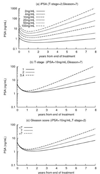Determinants of change in prostate-specific antigen over time and its association with recurrence after external beam radiation therapy for prostate cancer in five large cohorts
- PMID: 19014779
- PMCID: PMC2757130
- DOI: 10.1016/j.ijrobp.2008.01.056
Determinants of change in prostate-specific antigen over time and its association with recurrence after external beam radiation therapy for prostate cancer in five large cohorts
Abstract
Purpose: To assess the relationship between prognostic factors, postradiation prostate-specific antigen (PSA) dynamics, and clinical failure after prostate cancer radiation therapy using contemporary statistical models.
Methods and materials: Data from 4,247 patients with 40,324 PSA measurements treated with external beam radiation monotherapy in five cohorts were analyzed. Temporal change of PSA after treatment completion was described by a specially developed linear mixed model that included standard prognostic factors. These factors, along with predicted PSA evolution, were incorporated into a Cox model to establish their predictive value for the risk of clinical recurrence over time.
Results: Consistent relationships were found across cohorts. The initial PSA decline after radiation therapy was associated with baseline PSA and T-stage (p < 0.001). The long-term PSA rise was associated with baseline PSA, T-stage, and Gleason score (p < 0.001). The risk of clinical recurrence increased with current level (p < 0.001) and current slope of PSA (p < 0.001). In a pooled analysis, higher doses of radiation were associated with a lower long-term PSA rise (p < 0.001) but not with the risk of recurrence after adjusting for PSA trajectory (p = 0.63). Conversely, after adjusting for other factors, increased age at diagnosis was not associated with long-term PSA rise (p = 0.85) but was directly associated with decreased risk of recurrence (p < 0.001).
Conclusions: We conclude that a linear mixed model can be reliably used to construct typical patient PSA profiles after prostate cancer radiation therapy. Pretreatment factors along with PSA evolution and the associated risk of recurrence provide an efficient and quantitative way to assess the impact of risk factors on disease progression.
Conflict of interest statement
Figures



References
-
- Roach M, 3rd, Weinberg V, Sandler H, et al. Staging for prostate cancer: time to incorporate pretreatment prostate-specific antigen and Gleason score? Cancer. 2007;109(2):213–220. - PubMed
-
- Kuban DA, el-Mahdi AM, Schellhammer PF. Prostate-specific antigen for pretreatment prediction and posttreatment evaluation of outcome after definitive irradiation for prostate cancer. Int J Radiat Oncol Biol Phys. 1995;32(2):307–316. - PubMed
-
- Shipley WU, Thames HD, Sandler HM, et al. Radiation therapy for clinically localized prostate cancer: a multi-institutional pooled analysis. JAMA. 1999;281(17):1598–1604. - PubMed
-
- Zagars GK, Pollack A, Kavadi VS, et al. Prostate-specific antigen and radiation therapy for clinically localized prostate cancer. Int J Radiat Oncol Biol Phys. 1995;32(2):293–306. - PubMed
-
- Kestin LL, Vicini FA, Ziaja EL, et al. Defining biochemical cure for prostate carcinoma patients treated with external beam radiation therapy. Cancer. 1999;86(8):1557–1566. - PubMed
Publication types
MeSH terms
Substances
Grants and funding
LinkOut - more resources
Full Text Sources
Medical
Research Materials
Miscellaneous

